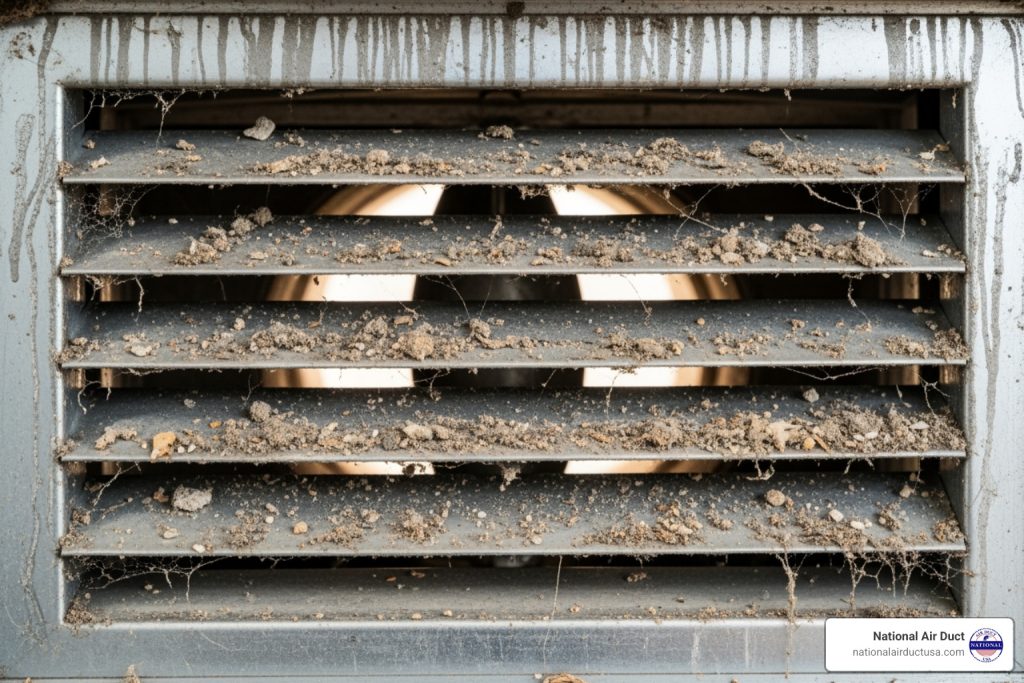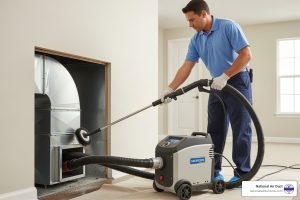More Than Just Dust – What’s Really in Your Air Ducts?
If you’re wondering how to disinfect air ducts, here’s what you need to know upfront:
Quick Answer:
- Physical cleaning first – Remove dust, debris, and contaminants with professional equipment
- EPA-registered disinfectants only – Use products specifically approved for HVAC systems
- Professional application required – Fogging technology ensures proper coverage and safety
- Not a DIY job – Improper chemicals or application can damage your system and create health risks
Your home’s air ducts circulate air through your living space five to seven times per day. That means whatever’s lurking inside those hidden passages gets breathed in by your family over and over again.
And it’s not just dust bunnies hiding in there.
According to research, the average family generates up to 40 pounds of dust annually through everyday living. But that’s just the beginning. Your ducts can harbor bacteria, mold spores, pet dander, pollen, and even viruses – especially concerning given recent awareness about airborne contamination.
According to the EPA, indoor air pollutants are often 2 to 5 times higher than outdoor levels – and in some cases can exceed 100 times outdoor pollution levels.
This matters because poor indoor air quality can worsen asthma, trigger allergies, and increase your risk of respiratory problems. For families with compromised immune systems or severe allergies, what’s circulating through your ducts becomes even more critical.
While regular duct cleaning removes the physical debris, disinfection targets the microscopic threats that cleaning alone can’t eliminate. But here’s the catch – it’s not as simple as spraying some chemicals into your vents.

Cleaning vs. Disinfecting: What’s the Difference and What Do You Need?
When we talk about air ducts, it’s easy to get “cleaning” and “disinfecting” mixed up. They both sound like they make things sparkle, right? But in HVAC, they’re two distinct processes, each with its own purpose and benefits. Think of it like washing your hands versus sanitizing them – both are good, but they tackle different levels of cleanliness.
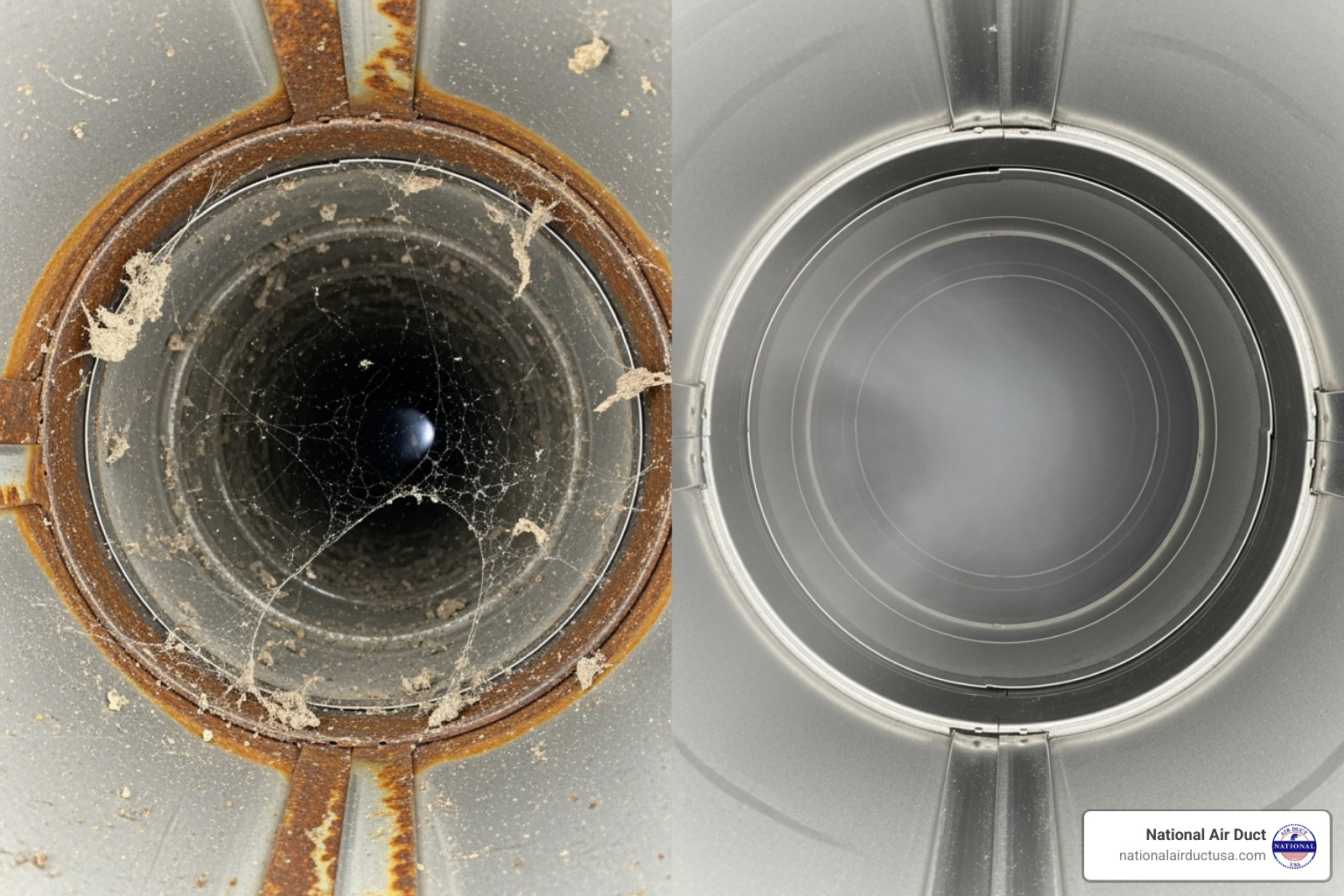
Standard Air Duct Cleaning: The Essential First Step
Standard air duct cleaning is all about physical debris removal. This is the foundational step, the heavy lifting that gets rid of the visible nasties. We’re talking about the accumulated dust, pet dander, hair, construction debris, and other physical contaminants that settle in your ductwork over time.
For this, professionals use powerful, specialized equipment. We use high-powered vacuums, often truck-mounted systems boasting an impressive 12,000 cubic feet per minute (CFM) of suction power (compared to a typical portable vacuum’s 5,000 CFM). These powerful machines, combined with agitation devices like rotary brushes and air whips (operating at 250 PSI of pressure), work to dislodge and extract all that grime.
Why is this so crucial? Because all that built-up debris isn’t just unsightly; it can clog your HVAC system, forcing it to work harder. This leads to wasted energy (the U.S. Department of Energy estimates 25% to 40% of energy used for heating/cooling is wasted!) and reduced efficiency. Removing these blockages improves airflow, helps your system run smoother, and can even extend its lifespan. A thorough physical cleaning is the essential first step to improving your indoor air quality and HVAC efficiency.
For more info, you can learn about our residential air duct cleaning services.
Air Duct Disinfection: When and Why It’s Necessary
Now, once the physical cleaning is done, we sometimes move on to air duct disinfection. This is where we target the invisible enemies – microbial contaminants like bacteria, viruses, and fungi that physical cleaning might not completely eliminate. Disinfection goes beyond just removing dirt; it actively kills these microorganisms.
So, when is this extra step necessary? It’s not a routine service, but rather a targeted solution for specific situations:
- Visible mold growth: If a professional inspection reveals mold within your ductwork, disinfection (after proper remediation and source removal) is critical to address the fungal spores.
- Musty odors: Persistent, unpleasant odors emanating from your vents, even after cleaning, can indicate the presence of bacteria, mold, or other microbial growth that needs to be neutralized.
- Pest or rodent infestation: Critters like rodents or insects can leave behind droppings, nesting materials, and bacteria. After removing the pests and their debris, disinfection helps sanitize the affected areas.
- After water damage: If your HVAC system has been exposed to water (e.g., from a leak or flood), there’s a high risk of mold and bacterial growth, making disinfection a vital step in restoration.
- Post-renovation dust and spores: While cleaning removes construction dust, renovations can also introduce new spores or contaminants that disinfection can address.
- Severe allergies or respiratory conditions: For household members with heightened sensitivities or conditions like asthma, disinfecting the ducts can significantly reduce airborne allergens and irritants, providing much-needed relief.
- Compromised immune systems: In homes with individuals who have weakened immune systems, reducing microbial load in the air can be a critical health safeguard.
The goal of disinfection is microbial control, leading to improved air quality, odor removal, and ultimately, peace of mind knowing that your air is as clean and healthy as possible. We also aim for allergy relief by reducing the presence of common airborne irritants.
If you’ve recently completed a home renovation, you can learn about air duct cleaning after renovation on our site.
How to Disinfect Air Ducts: The Professional Process for a Safe and Healthy Home
You might be thinking, “Great, so I just spray some cleaner in there, right?” Hold your horses! When it comes to how to disinfect air ducts, this is where the “professional” part really comes into play. It’s a precise process, guided by strict standards, ensuring both effectiveness and your family’s safety.
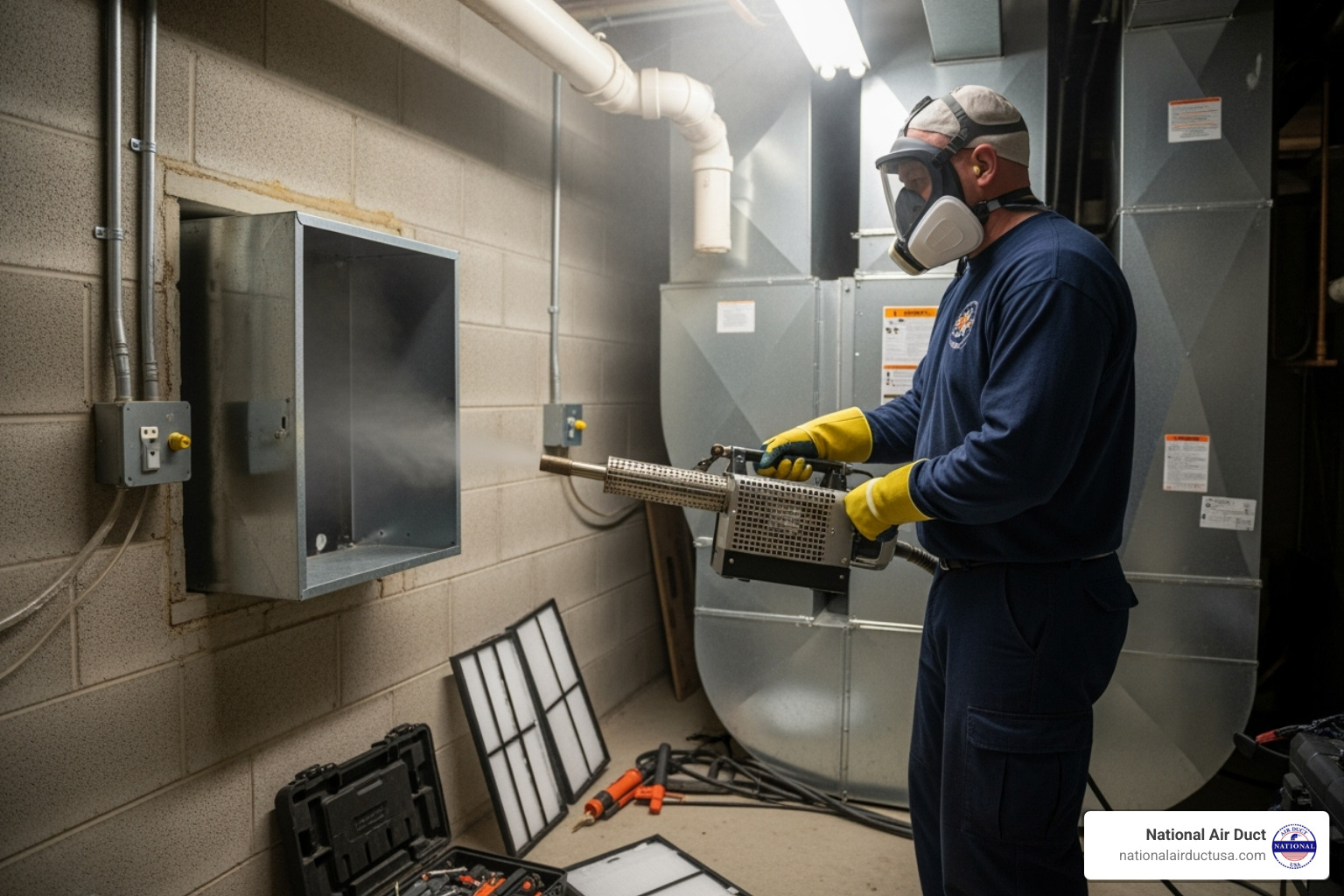
Why DIY Air Duct Disinfection is Not Recommended
We completely understand the appeal of a DIY project. There’s a real sense of accomplishment that comes from tackling things yourself. But when it comes to air duct disinfection, we strongly recommend against going it alone. This isn’t just about us being professionals; it’s about protecting your safety, your home’s integrity, and ensuring the job is done right.
Think about it: many household cleaners aren’t made for HVAC systems. Using the wrong chemicals can actually damage your ductwork or even release harmful fumes into your home. The law (specifically the Federal Insecticide, Fungicide, and Rodenticide Act, or FIFRA) is very clear: you can’t use these products in ways that aren’t on their label. Using them incorrectly isn’t just ineffective; it can be illegal and dangerous.
You might also find that trying to disinfect ducts yourself leads to inadequate application. Getting full, even coverage throughout all those nooks and crannies in your duct system is nearly impossible without specialized equipment. Plus, without proper ventilation knowledge, you could expose yourself and your family to health hazards from fumes. And let’s be honest, you probably don’t have the specialized equipment like high-powered vacuums, fogging machines, or the right personal protective gear that professionals use. As experts recommend, trying to clean ducts yourself can sometimes create more problems than it solves. It’s simply not worth the risk.
The Professional Disinfection Process Explained
So, if you’re serious about figuring out how to disinfect air ducts safely and effectively, here’s a look at the professional process we follow. We always stick to the high standards set by NADCA (National Air Duct Cleaners Association), ensuring top-notch results.
Step 1: Thorough Pre-Cleaning
This step is absolutely vital – you can’t skip it! Disinfectants work best when they’re applied to clean surfaces. Imagine trying to wash your hands if they were covered in mud; the soap wouldn’t really get to your skin, right? It’s the same with your ducts. If you spray disinfectant over layers of dust and debris, it won’t be able to reach and kill the microorganisms hiding underneath. That’s why our technicians always start with a comprehensive physical cleaning of your entire HVAC system. We use powerful truck-mounted vacuums and special tools to remove all that built-up dirt and contaminants. This “source removal” is the most important part of the whole process.
Step 2: Choosing the Right Disinfectant
After cleaning, we carefully select the disinfectant. We only use products that are EPA-registered and specifically labeled for use in HVAC systems. This means they’ve been rigorously tested and approved for safety and effectiveness in this unique environment. These are usually “broad-spectrum” disinfectants, meaning they’re good at tackling a wide range of bacteria, viruses, and fungi. For example, we might use products like Benefect Decon 30, which is a botanical disinfectant, or Bio-Fresh, known for being non-corrosive and free from harsh chemicals. These products are chosen for their proven ability to work and their low toxicity when used correctly.
Step 3: Application with Fogging Technology
Once the ducts are clean, it’s time to apply the disinfectant. We do this using special fogging or misting technology, like a ULV (Ultra Low Volume) fogger. This method turns the disinfectant into a super-fine mist that can float through and completely coat the inside surfaces of your ductwork. It ensures the disinfectant spreads evenly throughout the entire complex system, reaching all those hard-to-get spots that a simple spray can’t. We even use your HVAC system’s negative air pressure to help pull the fog through all the ducts, ensuring full coverage.
Step 4: Proper System Circulation and Ventilation
After applying the disinfectant, we usually run your HVAC system for a while. This helps the disinfectant circulate and settle properly. Our technicians are also experts at managing proper ventilation. This ensures any lingering fumes or scents from the disinfectant can safely dissipate. For example, some products like Decon 30 have a light, natural scent that usually disappears within about 40 minutes. Other products might require you to be out of the house for a few hours (typically 2-8 hours) to allow for complete air clearance. Your safety is always our absolute top priority during this stage.
For more information, we invite you to check out our disinfecting air duct services.
Are the Chemicals Used for Air Duct Disinfection Safe?
This is a really common and important question, and we’re always happy to answer it! The safety of the chemicals used for air duct disinfection truly depends on two key things: what product is used and how it’s applied.
First and foremost, we exclusively use EPA-registered products. This is non-negotiable. The Environmental Protection Agency (EPA) thoroughly tests and approves products for specific uses, including inside HVAC systems. If a product isn’t EPA-registered for this particular use, it simply shouldn’t be used. This ensures that the product has been checked for its potential impact on people and the environment when used in your home’s air system.
Many of the professional disinfectants we use, like Benefect Decon 30, are actually botanical disinfectants, often made from natural ingredients like thyme. Decon 30, for example, uses thymol as its active ingredient and has the EPA’s lowest toxicity rating. This means it’s extremely safe when used as directed. Other products we use are known for being non-corrosive, meaning they won’t damage your ducts, and are generally considered non-hazardous to human health.
Even with these safe, EPA-registered products, proper application is key. Our certified technicians are specially trained to apply these solutions precisely. They make sure the disinfectant coats surfaces effectively without using too much or creating any hazardous conditions. They also know exactly how to manage ventilation and re-entry times, if needed, allowing any faint, residual scents to clear out before you return to your normal routine. The guidance from the EPA stresses that these products should only be used after your ducts have been thoroughly cleaned and only if there’s a real need for disinfection. This way, we avoid any unnecessary chemical exposure and make sure the treatment is truly effective. You can find more guidance on using an EPA-registered solution on their website.
The Rules of the Game: Safety, Risks, and Legal Considerations
When we talk about how to disinfect air ducts effectively and safely, it’s not just about spraying a solution and hoping for the best. There’s a serious side to this process involving consumer protection, your family’s health, and strict regulatory compliance. We take all of these aspects very seriously.
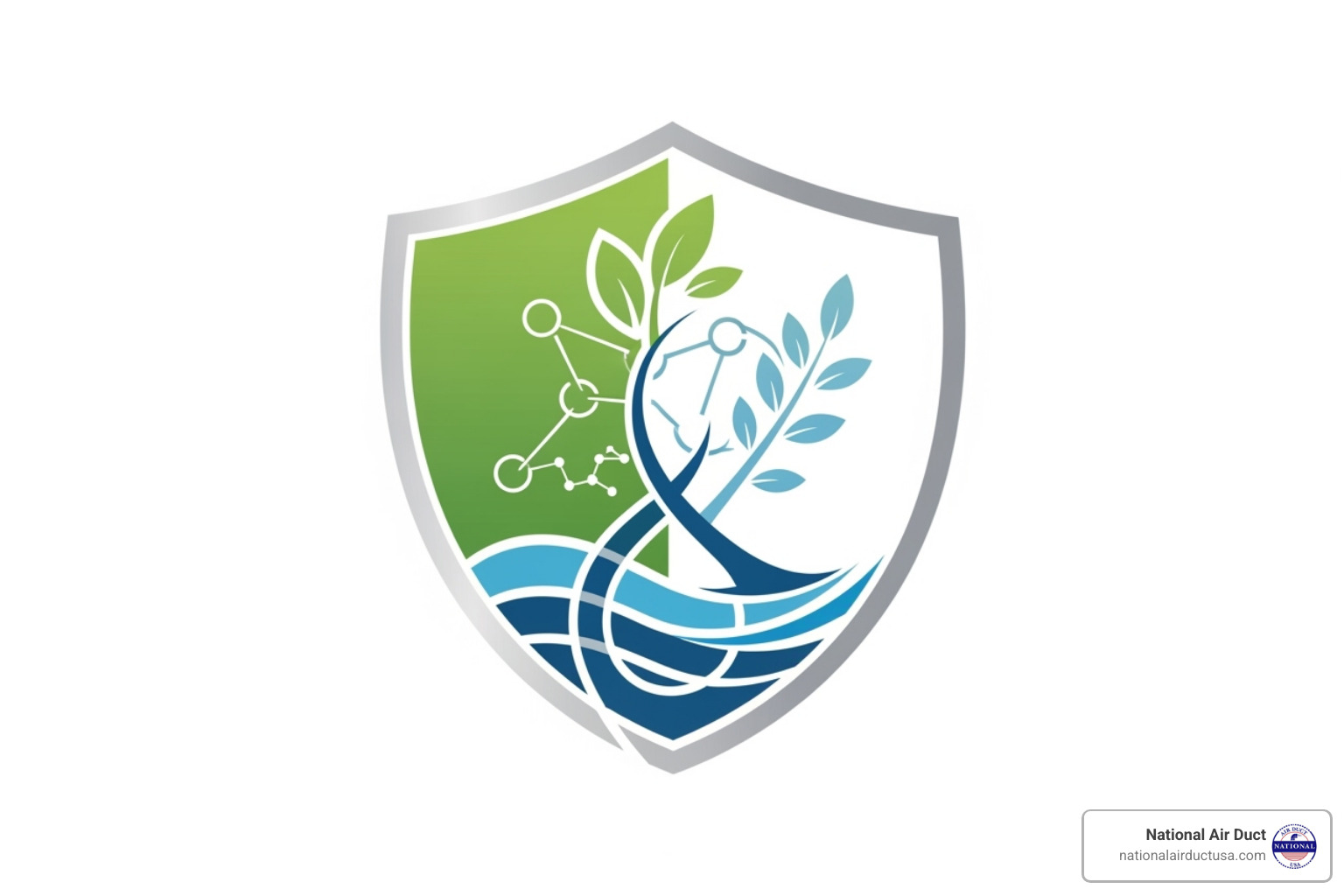
Potential Risks and Limitations
While professional air duct disinfection offers fantastic benefits for your home’s air quality, it’s super important to understand that there are potential risks if it’s not done correctly. This isn’t a task for just anyone with a spray bottle!
First, there are health risks from improper chemical application. If a company uses chemicals not approved by the EPA, applies too much, or doesn’t ventilate your home properly afterward, it can lead to respiratory problems, headaches, and other uncomfortable health issues for you and your family. We’ve even seen reports linking unapproved antimicrobial applications to adverse health effects.
Second, there’s a real danger of damage to your HVAC components or duct materials. Harsh, unapproved chemicals can corrode the metal parts of your system or damage your ductwork, especially flexible ducts. This can lead to costly repairs and make your HVAC system run less efficiently.
Third, disinfection will be ineffective if not preceded by thorough cleaning. Remember how we said pre-cleaning is crucial? If you spray disinfectant over layers of dust and grime, the chemicals simply won’t reach the tiny microbes hiding underneath. It becomes a waste of time and money, and your ducts won’t actually be disinfected.
Finally, while disinfection offers great benefits, it’s important to know about recontamination possibility. Disinfection isn’t a permanent shield. Once your HVAC system turns back on, fresh air brings in new particles, and your ductwork can become recontaminated over time. While some treatments can last several months, maintaining good indoor air quality also requires regular filter changes and routine HVAC maintenance.
Understanding the Law: FIFRA and Your Safety
This is where the legal stuff comes in, and it’s incredibly important for your safety and for honest business practices. In the U.S., the Federal Insecticide, Fungicide, and Rodenticide Act (FIFRA) is a federal law that oversees the registration, sale, and use of products like disinfectants and sanitizers.
So, why does FIFRA matter to you, the homeowner?
The biggest takeaway is this: using products inconsistent with their labeling is illegal. This is a core principle of FIFRA. If a product’s label doesn’t specifically say it can be used inside or on HVAC systems, then using it for air duct disinfection is against federal law. The EPA has pointed this out many times because many general household disinfectants are simply not approved for this specific, specialized use.
This means the product label is the law. It contains vital information on how to handle the product safely, how to apply it correctly, how long you might need to stay out of your home, and where it’s approved for use. Our technicians are highly trained to follow these instructions to the letter, ensuring your safety.
Being aware of FIFRA also helps you avoid scams and fraudulent claims. Be very careful of companies that make big, unproven promises about “sterilizing” or “purifying” your air ducts, especially if they don’t clearly talk about using EPA-registered products or the absolute necessity of cleaning your ducts first. Organizations like NADCA (National Air Duct Cleaners Association) warn against these kinds of misleading claims, which unfortunately give the entire industry a bad name. Some companies might just fog your home without truly disinfecting anything, charging you a lot for very little benefit.
The EPA has expressed serious concerns about using antimicrobial products in HVAC systems without proper authorization because of potential health risks and unproven effectiveness. They stress that physically removing contaminants is the best way to clean HVAC systems. Chemical applications should only be an added step if truly needed, and only with an EPA-registered product approved for that specific use. We pride ourselves on being completely transparent and always following these regulations to protect your home and health.
Frequently Asked Questions About Air Duct Disinfection
We often get a lot of questions about air duct disinfection, and we’re here to clear the air (pun intended!). Here are some of the most common inquiries we receive, giving you a clearer picture of how to disinfect air ducts safely and effectively.
How do I choose a reputable company for air duct disinfection?
Choosing the right company is super important for effective and safe air duct disinfection. After all, you’re inviting them into your home and trusting them with your air quality! Here’s what we at National Air Duct USA always recommend looking for:
First and foremost, look for NADCA certification. This is truly the gold standard in our industry. It means the company, and its technicians, have met the highest standards for training, equipment, and cleaning procedures. National Air Duct USA is proud to be NADCA-certified, ensuring you get professional and proper service every time.
A reputable company will always provide proof of insurance. This protects you and your property in case of any unexpected issues. It’s a simple, but vital, sign of professionalism and accountability.
When you’re getting quotes, make sure they are detailed and in writing. A clear quote should outline exactly what services will be performed, the specific EPA-registered products they plan to use, and the total cost. Be wary of hidden fees or vague pricing that seems too good to be true.
Also, pay attention to their sales approach. A professional company will educate you, not try to scare you into buying services. They won’t use high-pressure tactics or make wild, exaggerated claims about health benefits without proper context. We believe in providing clear, honest information so you can make an informed decision.
Lastly, don’t hesitate to ask about the specific EPA-registered products used. A good company will be completely transparent about the disinfectants they plan to use, providing product names and explaining their safety profiles. We’re always happy to discuss the products we use and why they’re the best choice for your home.
How often should I disinfect my air ducts?
This is a really important question, and here’s the straightforward answer: air duct disinfection is not a routine service. Unlike changing your furnace filter or getting your car’s oil changed, it’s not something that needs to be done on a regular schedule every year or two.
Instead, disinfection should only be considered when a specific problem exists in your ductwork. Think of it as a targeted solution for particular issues, such as:
- Visible mold growth within your ducts.
- A confirmed pest or rodent infestation that has left behind debris or odors.
- Persistent, musty odors coming from your vents, even after a thorough cleaning.
- After your HVAC system has experienced water damage (like from a leak or flood).
- If someone in your household has severe allergies, a respiratory illness, or a compromised immune system, and your HVAC system is suspected to be contributing to their symptoms.
While some disinfectant treatments, like certain long-lasting solutions, might claim to be effective for up to six months, this doesn’t mean you need to disinfect every half-year. The main focus should always be on preventing issues in the first place (like regular filter changes and managing humidity) and thorough physical cleaning to remove the source of contaminants. Disinfection is a powerful tool, but it’s used for specific microbial problems, not general maintenance.
Can disinfection improve my HVAC system’s efficiency?
This is a great question! Here’s the deal: disinfection itself doesn’t directly improve your HVAC system’s efficiency in the same way that cleaning does. Think of it this way: the disinfectant works to kill microbes like bacteria and mold, but it doesn’t remove physical blockages or dust buildup.
However, there’s a big “but” here. The process of disinfection is always preceded by a thorough physical cleaning. This pre-cleaning step is absolutely mandatory and is what truly impacts your system’s efficiency. By removing all that accumulated dust, pet dander, and other debris from your ductwork, we eliminate the blockages that force your HVAC system to work harder.
When your ducts are clean, air can flow much more freely. This reduces strain on your furnace and air conditioner, allowing them to operate more effectively and efficiently. This can lead to lower energy bills and even extend the lifespan of your HVAC system. A clean system simply wastes less energy, which is a win for your wallet and the environment!
So, while disinfection targets the health aspect (killing germs and mold spores), it’s the comprehensive cleaning that comes first that directly contributes to improved airflow and overall system efficiency. And for even more comprehensive HVAC efficiency, consider our specialized services like HVAC Coil Cleaning, which is a critical part of your system’s performance.
Conclusion: Breathe Easier with Professionally Disinfected Air Ducts
We’ve covered quite a bit about how to disinfect air ducts, and hopefully, you now have a much clearer picture of what this specialized service truly entails. Air duct disinfection isn’t just a routine cleaning task you do every year. Instead, it’s a targeted solution, specifically designed to tackle those microscopic troublemakers like mold, bacteria, and viruses. It’s especially important in particular situations, such as when you have confirmed mold growth, a pest problem, or persistent, lingering odors.
The role of professional expertise in this process really can’t be stressed enough. Unlike a simple cleaning job, air duct disinfection involves specialized equipment and the careful use of EPA-registered chemicals. These solutions need to be applied precisely and safely to be effective. Trying to disinfect your ducts yourself as a DIY project can unfortunately lead to a few problems: ineffective results, potential damage to your valuable HVAC system, and even harmful exposure to chemicals for you and your family.
At National Air Duct USA, we’re proud to be NADCA-certified professionals. This isn’t just a fancy title; it means our team adheres to the very highest industry standards when it comes to assessing, cleaning, and restoring HVAC systems. Our comprehensive approach ensures that your ducts aren’t just physically clean, but also properly disinfected when the need arises. We always use safe, EPA-approved products and follow proven methods to get the job done right.
Our goal is to truly improve your indoor air quality, help your HVAC system run more efficiently (saving you energy!), and ultimately, give you that wonderful peace of mind in your home. Don’t let hidden contaminants linger in your air ducts. If you suspect your home could benefit from professional air duct disinfection, or if you simply need a thorough, professional cleaning, we’re here to help. Our team provides professional, comprehensive, and affordable solutions for residential clients throughout NY, including Westbury and New York City.
Contact us for professional disinfecting air duct services today, and let us help you breathe easier!

